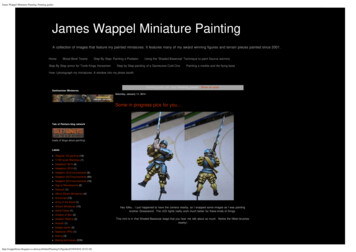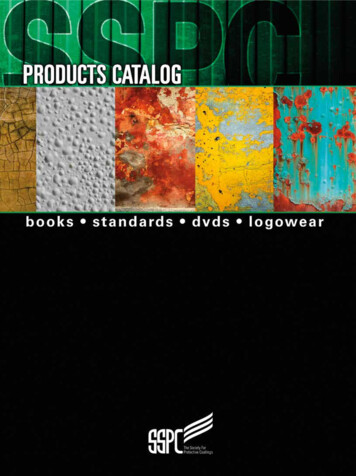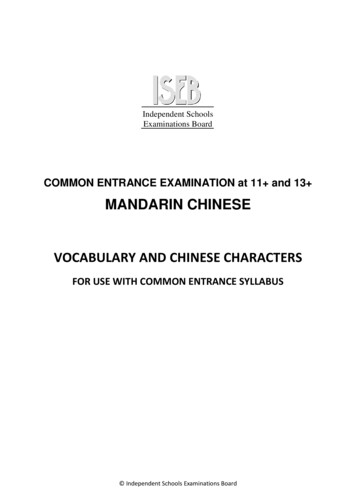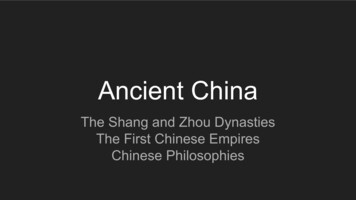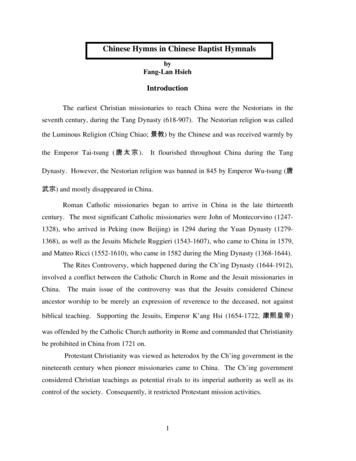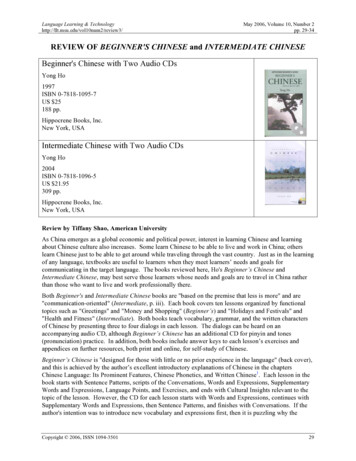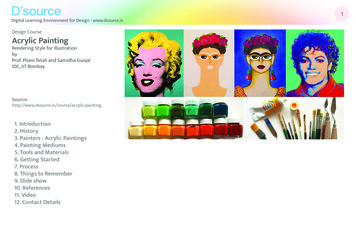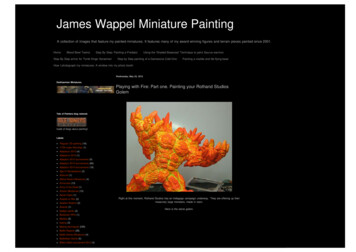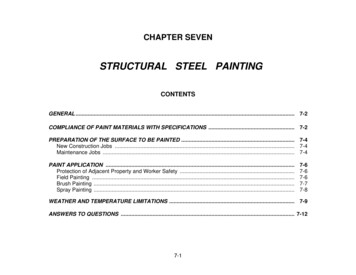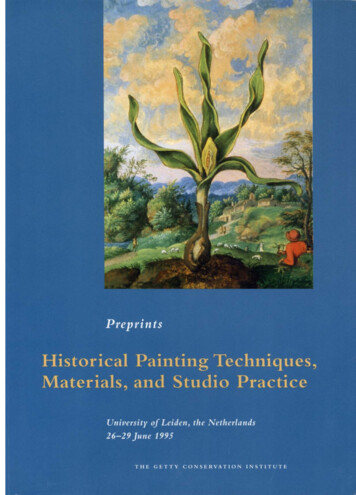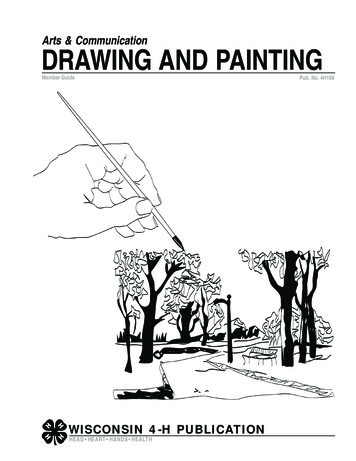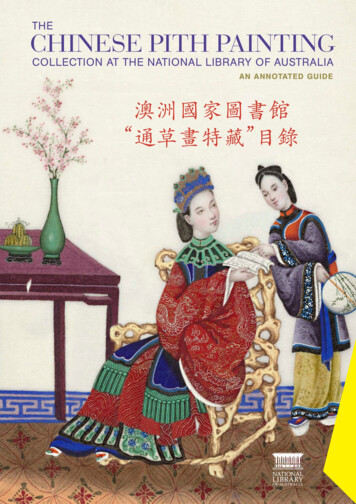
Transcription
THECHINESE PITH PAINTINGCOLLECTION AT THE NATIONAL LIBRARY OF AUSTRALIAAN ANNOTATED 錄
The CHINESE PITH PAINTING COLLECTIONat the NATIONAL LIBRARY OF AUSTRALIAAn annotated 錄i
Published by the National Library of AustraliaParkes PlaceCanberra ACT 2600T 02 6262 1111F 02 6257 1703National Relay Service 133 677www.nla.gov.au/ABN 28 346 858 075 National Library of Australia 2017Cover image:Recognising words – from the ‘Album of court life and court figures in Qing dynasty China’Sheet; 32 x 22 cm(China: ca.1840)nla.gov.au/nla.cat-vn7284938ii
PrefaceIn 2016 the National Library of Australia staged the exhibition Celestial Empire: Life in China1644 – 1912 which allowed visitors to experience 300 years of Chinese culture and tradition.The exhibition was a partnership between the National Library of Australia and the NationalLibrary of China and was a wonderful success with over 80,000 visitors attending the Libraryto view the exhibition or attend associated events.Both national libraries contributed items to the exhibition and together they showed life atcourt to life in the villages and fields as well as drawings and plans for Beijing’s iconicpalaces from the Yangshi Lei Archives, listed on UNESCO’s Memory of the World Register in2007 and never before seen in Australia.A number of the Library’s collection of pith paintings featured in Celestial Empire and thesecaught many visitors’ attention with their vivid colours and depiction of a wide variety ofscenes.The Library’s end of year donation appeal in 2016 coincided with Celestial Empire and wewere delighted with the response from the public. The funds donated have been directedto preserving the paintings and having them housed appropriately. We have alsoresearched each painting carefully and have used this information to upgrade the cataloguerecords, meaning they are much easier to find and discover. This collection guide has beenproduced and all of the paintings have also been digitised and are now able to be viewedthrough the online catalogue.The Library is grateful to those members of the public who supported the appeal which means thispart of our collection is now fully preserved, discoverable and available for all Australians.Alex PhilpDirector, Overseas Collections and Metadata ManagementNational Library of AustraliaNovember 2016iii
IntroductionIn the early 19th century the West was fascinated by China, but access to the country was severelyrestricted. From 1757 to 1842 Canton (Guangzhou) on the Pearl River in South China was the onlyport open to Western traders. As commerce boomed more and more foreign merchants and sailorscame to Canton. They were only permitted to trade there for about six months of the year and allhad to withdraw to the Portuguese settlement of Macau for the rest of the time. The main productsthe traders sought were silk [Bib ID 6610509], porcelain [Bib ID 5565307 nla.obj-114447422] and inparticular tea [Bib ID 6614119]. Western demand for tea soared after 1800.The influx of visitors created a market for small, portable and inexpensive mementos of China whichthey could take home for themselves, their families and friends. Canton-based artists had long beenproducing art works designed solely for foreigners. Painted on canvas, European or Chinese paper,or media such as glass and ivory, only wealthy sea captains and merchants could afford them.Something less costly was required for the ordinary visitor. The Canton artists turned to a localproduct which was cheap and plentiful, a small evergreen tree called Tetrapanax papyrifer, known inChinese as tongcao, which grew in southern China and on the island of Taiwan. The white pith of thistree had long been used to make artificial flowers, and for Chinese medicine.Unlike paper which is manufactured from wood or other fibres, the pith was cut directly from theinner spongy cellular tissue of the Tetrapanax. The trees were usually harvested when still young,while they contained a solid core of pith. Harvested branches or stems were cut into short lengths,which were soaked to make the pith easier to extract. This was achieved by stripping off the bark orforcing the pith out with a wooden or metal implement. The pith was then skilfully cut into thinsheets ready for painting.The oldest known Chinese watercolours painted on pith date from the mid-1820s. Australians tookan early interest in them. On 25 April 1829 the Sydney Gazette was advertising pith paintings for saleunder the heading New China Goods. On 11 October 1884 the Melbourne newspaper, The Argus,reported on a recent visit to a studio in Canton which produced pith paintings. The articlecommented on the watercolours’ “skillful treatment of subject and brilliancy of colour.”The small, brightly coloured paintings were not created by a single artist but by a studio employing anumber of artisans, who completed different parts of the work. These craftsmen painted withgouache, meaning watercolours with an added white pigment. This was applied thickly onto the soft,translucent surface of the pith, producing a raised effect. The close similarity of some of the picturesresults from mass-production techniques. Templates were widely used to provide the outlines offigures, which could then be coloured. Chinese watercolours on pith have sometimes been callediv
rice paper paintings in English. This is incorrect as they have nothing to do with rice and the pith isnot manufactured like paper.Some studios or workshops were directed by established artists such as Tingqua (1809-1870 ), theportrait and still life painter [see Bib ID 6094771] and Sunqua, [Bib ID 6614115] known for his oilpaintings of ships and port scenes. Both men were active in Canton between 1830 and 1870. Pithwatercolours produced by their studios are represented in the Library’s collection. Once completedeach pith painting was placed on Chinese or Western paper as backing, the pith edges were boundwith Chinese silk ribbon or coloured paper and the pages were then bound between album coversmost commonly in groups of twelve. Each album usually covered a single subject, for examplecostumes, boats or trades.In 1844 an American visitor to Canton, Osmond Tiffany, described what was for sale from theworkshops. “In every artist’s studio are to be found the paintings on what is called rice paper [i.e.pith]. This is very delicate and brittle, and nothing can exceed the splendour of the colours employedin representing the trades, occupations, life ceremonies, religions, etc, of the Chinese, which allappear in perfect truth in these productions [They] may be obtained for a very reasonable sum, inboxes or bound up in books. They cost, for the usual class of excellence, from one to two dollars adozen Or you may order a set comprising the emperor and empress, and the chief mandarins, andcourt ladies, in the most significant attire, and finished like miniatures, for eight dollars.”As Tiffany indicates, the pith paintings dealt with many aspects of Chinese life which appealed toforeigners. They have been called the picture postcards of their day. Some of the best depicted thecourt and costumes of the Manchu emperors and their senior officials. The Manchus ruled China asthe Qing dynasty from 1644 to 1911. The National Library holds several beautiful albums showinggorgeously dressed emperors [Bib ID 6857256 nla.obj-316231147], empresses [Bib ID 6857256nla.obj-316231270] and high officials [Bib ID 6857256 nla.obj-316231461].Unlike many of the watercolours whose origins we do not know, two of these albums came from thestudios of the famous artists, Tingqua [see Bib ID 6094771] and Sunqua, both mentioned above.Sunqua’s studio label is attached to a volume showing emperors, empresses and Chinese gods [seeBib ID 6614115 nla.obj-93346270]. A two volume set on the life and costumes of China’s rulers [BibID 2508932] is signed by its early owner, S.W.Steedman. The Rev. Samuel Watson Steedman was anAnglican minister, who was in Canton in 1849 and was appointed colonial chaplain in Hong Kong in1852. Later these volumes were presented to the National Library by Gertrude F (Jean) Williams, alover of Chinese art, who lived in Japan for many years with her Australian husband Harold S.Williams, donor to the Library of a major collection about Japan and the West. A similar album [BibID 1984376] is part of the Simon Collection on East Asia, acquired by the Library in stages between1970 and 1982. Professor Walter Simon (1893-1981) wrote extensively on the Chinese, Manchu andTibetan languages. Another set of 12 paintings [Bib ID 6857256] showing an emperor, empress andsenior officials with their wives, which quite unusually includes titles of rank in Chinese and Englishprinted under each image, has been signed Lilian? Saddler.It is not only pith paintings about imperial or official life for which we have details of provenance. Analbum depicting the various stages of tea production from preparing the ground for planting teabushes to tasting the finished product [Bib ID 6614119] may possibly come from the studio of theprominent Canton artist Youqua. Active between 1840 and 1870, he was highly regarded for his portv
scenes, landscapes and still life paintings. Youqua had studios in Canton and Hong Kong creating pithpaintings. Sometimes an early owner has inscribed an album, as in the examples from Steedman andSaddler above. A collection of theatrical scenes showing military figures from China’s past [Bib ID6574402] has been signed J.S. Brown “Frogmore.” In 2016 the Library acquired a magnificent leatherbound scrapbook album with a title label which reads “Rice Drawings” [Bib ID 7252084]. It is filledwith Chinese pith paintings of birds, flowers, women and boats as well as European engravings. Thescrapbook contains the bookplate of the Reverend William Tew, a Protestant minister in CountyKildare, Ireland in the late 18th and early 19th century. Opposite the bookplate is written neatly thename Hester Tew and the date January 6 1840. She was probably William Tew’s daughter or niece.Also in 2016 Dr Anna Gray, former Head of Australian Art at the National Gallery of Australia,donated a set of pith paintings [Bib ID 7253371] on various forms of gambling in China.Other popular topics for watercolours were the ships and boats which plied the seas and inlandwaterways around Canton [Bib ID 6485019]; the criminal justice system, whose judicial tortures andpunishments held a gruesome fascination for visitors [Bib ID 2508879]; festive events such as awedding banquet [Bib ID 7084772] or a theatrical performance [Bib ID 6437829].The Library houses an album of pith paintings devoted to Chinese ships and boats [Bib ID 6485019].Canton with its many waterways and islands was a hive of boating activity. Boats were major formsof transportation, and would have been very familiar to foreign visitors. Although the execution isnaïve and the boats and human figures out of proportion, the brightly coloured album is historicallyvaluable in displaying a range of 19th century Chinese watercraft. There is an ocean-going sailing ship[Bib ID 6485019 nla.obj-153455046] distinguished by the large eyes painted on each side of thebows, and believed to ward off disaster on the high seas. A dragon boat [Bib ID 6485019 nla.obj153454447], brightly adorned with flags, drum and gong, would have been involved in racing duringthe dragon boat festival on the fifth day of the fifth lunar month. The duck boat [Bib ID 6485019nla.obj-153456097] was used to rear and transport ducks, which were let out to feed along theriverside during the day and returned to sleep in the boat at night. Many Australians will recall fromtheir childhoods Margaret Flack’s “The Story about Ping”, the adventures of a duck from a Chineseduck boat.In addition to the album containing 12 pictures of boats, the Library holds a scrapbook [Bib ID7252084] which among other pith paintings includes four striking images of Chinese vessels. Thehandwritten date in this scrapbook, January 6 1840, strongly suggests that the images are quite earlyones. The boats are depicted in much finer detail and the colouring is subtler than in Bib ID 6485019.The latter is almost certainly from a later period, when the artistic quality of pith paintings beingproduced was generally lower than in the early years.Criminal justice in China was among the most popular subjects for pith paintings. Foreign visitorswere fascinated by a legal system where the accused was not represented and judicial torture wascommon. There was a macabre interest in the harsh interrogation methods used to extractconfessions, such as the finger press, face slapping and suspension by ropes, as well as punishmentsranging from beating with bamboo or being forced to wear a wooden yoke (cangue) up to executionby strangulation, beheading or for the most heinous crimes slicing. The Library currently houses fouralbums of pith paintings about criminal justice in 19th century China [Bib ID 2508879; 5514335;6005086; 6487846].vi
Many of the pith paintings held by the Library cover aspects of everyday Chinese economic andsocial life. Though generally less sophisticated than the albums on emperors and high officials, theyare historically important in bringing to life street traders [Bib ID 2510774 nla.obj-148510619],flower sellers [Bib ID 2510774 nla.obj-148512642], musicians and entertainers [Bib ID 5783555] ,religious figures [Bib ID 5832356], workers in the silk [Bib ID 6610509] and tea industries [Bib ID6614119], an outdoor barber [Bib ID 2510774 nla.obj-148512492] , a fisherman [Bib ID 5832354nla.obj-152750520], a wood cutter [Bib ID 6438684] and numerous other occupations.Pith painting flourished between the 1820s and 1860s. In 1835 there were believed to be some 30shops selling pictures near the foreign quarter of Canton. After China’s defeat in the First Opium War(1839-1842) she was forced to cede Hong Kong to Britai
lover of Chinese art, who lived in Japan for many years with her Australian husband Harold S. Williams, donor to the Library of a major collection about Japan and the West. A similar album [Bib ID 1984376] is part of the Simon Collection on East Asia, acquired by the Library in stages between 1970 and 1982. Professor Walter Simon (1893-1981) wrote extensively on the Chinese, Manchu and Tibetan .
